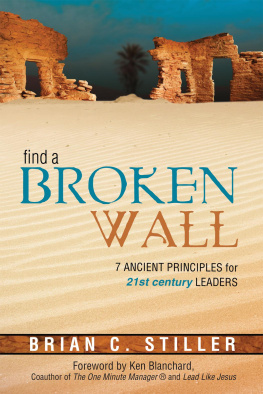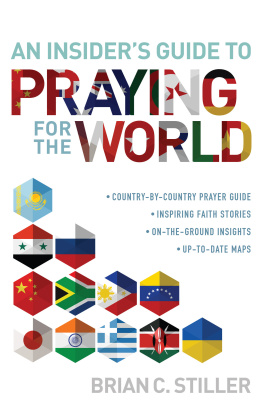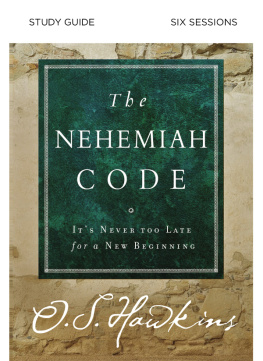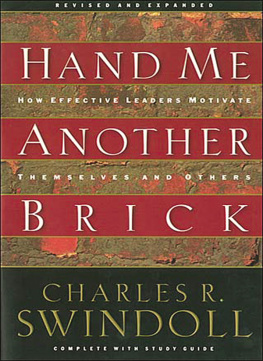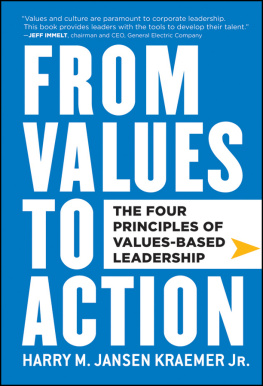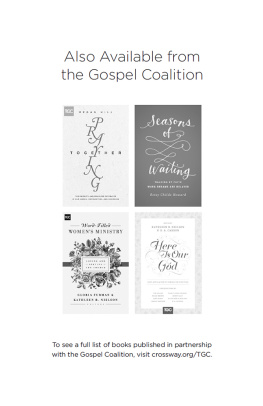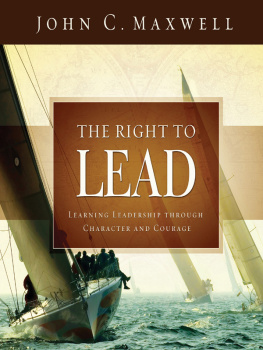Dedication
To those who over my lifetime have enabled me by their friendship and support in leading local and national ministries
Principle 5: Bridge the Dialectic of Passion and Planning
Write it down. Written goals have a way of transforming wishes into wants; cants into cans; dreams into plans; and plans into reality. Dont just think it; ink it!
Author Unknown
A schedule defends from chaos and whim. It is a net for catching days. It is scaffolding on which a worker can stand and labor with both hands at sections of time.
Annie Dillard
To a visionary, fueled by the possibility of faith in action, planning sounds almost like unfaith, as if thinking about the steps in making the vision a reality is a sort of doubt.
Importance of Strategic Planning
Being able to see from 33,000 feet has its problems, as Ive often learned. From that vantage point Im able to describe the vision, what will be in five years. The story of what has been, what is, and what will be plays like a well-rehearsed concerto. What I struggle with is breaking it down into steps, getting from here to there.
Often, in articulating a vision I knew the broad strokes of strategy, but knowing that only complicated it for others. The strategy wasnt sufficiently detailed for the team who had to manage it to fulfillment.
As I pointed out in the previous chapter, in my last years as president of YFC, I confused my senior team with ideas that made perfect sense to me, but because they hadnt been agreed on and connected to the vision and mission, I was out on my own. Senior staff assumed I had lost interest in the work. In a way they were rightI was tired with the role and with being unable to mobilize the team to growth. But rather than work with them in developing a strategy, I created new plans and developed new teams. This led to a misunderstanding. How much better it would have been if I had been disciplined to develop a working plan that had everyone onside.
Fixing broken ministries requires more than passion. Coordinating volunteers, protecting them from enemies, encouraging them to keep going in the face of danger requires passion. Hearts filled with a desire to see the project finished are essential to the strategy. But it takes more than that.
Important ideas become reality when a plan is designed and carried out. The building of a major work takes years in the planning, as North Americans learned from the Japanese. Someone noted, It takes the Japanese ten years to plan and one year to implement; North Americans take one year in planning and ten in implementation.
Passion without planning leads to chaos. Montreals Expo 67, Man and His World, was a marvelous event, but lack of preparation resulted in a massive overrun of costs in a driving urgency to get it done on time. The enormous debt, which required the province of Quebec to levy an extra property tax, took four decades to pay off.
As passionate as you are, your vision and need for activity must not keep you from putting in place a strategic planor at least appointing someone (from within or from the outside) to help you.
A romantic read of Nehemiah overlooks the impact of his planning and forethought. Overcome by the force of his vision, we might ignore the deliberate and progressive ingredients of his planning and execution. Nehemiah had to convince the most powerful leader on earth to buy into his idea. Such persuasion required him to have a plan. Notice what he identified and the steps he took:
1. He convinced the king to allow him to return to Jerusalem. His presentation would have been filled with passion and color. Vision played into the story he told. Even so, it was a careful step, located in a plan. This first step was necessary, for only then could he proceed to the next.
2. He worked out sufficient detail to persuade the king to provide financial support. Such a king wouldnt risk international conflict simply on a well-told story. The king needed to see that the project was doable and that Nehemiah had sufficient understanding of what it took to get it done.
3. Nehemiah had the foresight to get letters of introduction for both safe passage and acquisition of building materials. Paperwork! The bane of visionaries. Great ideas described with great passion and conviction fall to the floor over a failure to do the groundwork. I know, for there have been too many such ideas in my life for me to ignore.
4. Then he made a deal with Asaph for lumber. It was possible because he had requested an introduction. Bluster wouldnt work. As powerful as Nehemiah was within his own regime, he understood politics. He knew the critical nature of having the king open the door. That took planning. (Later in the book, Ill address the politics of operation.)
5. If Nehemiah had arrived in Jerusalem without the necessary resources, all the great speeches in the world would not have overcome the need for lumber. An estimate of what was needed allowed him to gather supplies so that when it was time to go to work they had what was needed.
6. He needed authority, so he asked to be called governor of Judah. This critical position gave him leverage to deal with a debilitating problem of the poor being charged high interest. His forethought kept him from being hemmed in by the social and political dynamics of the complex world of Jerusalem.
7. It took more than enthusiasm to get the Jerusalem Jews into action. They needed to be organized. Collecting people with passion for the project required plans.
What Is Strategic Planning?
Strategic planning is more than writing out a strategy and listing the ingredients required. It is first about thinkingthinking what is, what needs to be, what can be done, and ways it can be accomplished. It starts with thinking about the bigger picture.
Nick Carter, of Andover Newton Seminary, says that strategic planning falls into three categories: problem planning, long-range planning, and transformative planning. All three have value. However, here I want us to understand transformative planning: a process that transforms what is, to rebuild the broken.
In his book Unfunded: From Bootstrap to Blue Chip, Starting a Fire without the Fuel of Round-A Capital , Carter suggests four important considerations in strategic planning:
1. Each business, organization, and agency has its own history, ethos, and community. Strategic planning formats are many. Carefully determine what is appropriate for your setting.
2. The vitality of your organization depends on you, the leader, to think and lead strategically and to create energy in planning strategically with others.
3. Your vision comes from within, not without. It cannot be imposed.
4. Strategic planning will, in the end, be one of the most important initiatives you will lead.
What is the value of a strategic plan?
It brings vision from 33,000 feet to ground level.
Visionaries by nature visualize the project completed but might find it difficult to describe its elements. Calling on the visionary to be more specific presses him or her to unwrap the ideas with more specificity. It forces vision to be broken up into bite-sized chunks.
It helps demonstrate the visions workability and possibility.
How many ideas find their way into reality? Inventors try and try and, after scores of attempts, see only a low percentage of ideas actually take off. Ministries that deal in the less-than-quantifiable world of spiritual well-being have greater difficulty in achieving concrete results than a business. That makes it even more important to work at identifying the plan.
It shows the weaknesses of the organization and what is needed to complement its operation.
Fearful of opposition, a visionary may believe there are no weaknesses or that identifying them will unravel the vision. The better an idea is refined, the greater the possibility of success.
Next page
